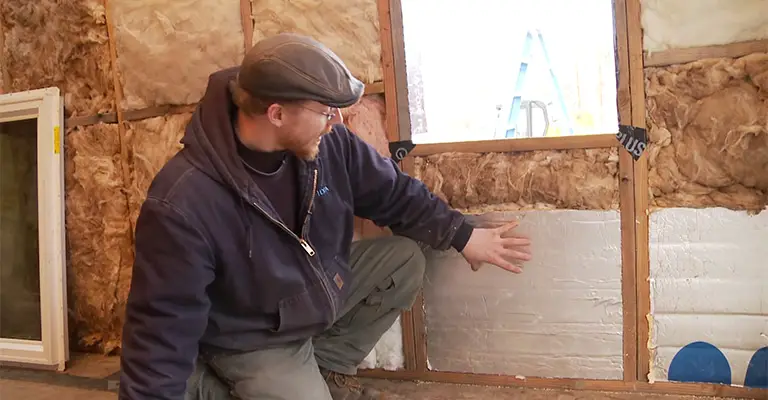Creating a comfortable and energy-efficient living environment involves careful consideration of insulation choices and moisture management.
Among the various insulation methods, blown-in insulation has gained popularity for its effectiveness in improving thermal performance.
However, a critical aspect of insulation installation is understanding whether a vapor barrier is necessary.
The decision to include a vapor barrier hinges on a range of factors, including climate, insulation type, construction methods, and local building codes.
In this exploration, we delve into the intricacies of blown-in insulation and its potential need for a vapor barrier, offering insights to help homeowners and builders navigate this crucial aspect of home insulation.
As long as proper ventilation is not provided, vapor retarders are required, whether fiber glass or cellulose is blown in.
Material used for vapor retarders for blown-in insulation must have a perm rating of less than 1 perm as with fiber glass batt insulation.
Does Blown In Insulation Need A Vapor Barrier?
Blown-in insulation, such as cellulose or fiberglass insulation, can benefit from a vapor barrier in certain situations, but whether or not you need one depends on your specific circumstances.
A vapor barrier, also known as a vapor retarder, is a material used to prevent moisture from migrating through walls, ceilings, and floors where it can condense and cause issues like mold, mildew, and rot.
Here are some factors to consider when determining whether blown-in insulation needs a vapor barrier:
Climate and Humidity
If you live in a climate with high humidity levels, a vapor barrier may be more necessary to prevent moisture from moving through the insulation and causing problems.
In colder climates, the vapor barrier is typically placed on the warm side of the insulation to prevent warm indoor air from reaching the colder exterior surface and condensing.
Wall Assembly
The type of wall assembly you have can influence the need for a vapor barrier. In some cases, the wall materials themselves may act as vapor barriers or vapor retarders.
Consult with local building codes or a professional to determine the best approach for your specific wall assembly.
Air Sealing

Proper air sealing is crucial regardless of whether you use a vapor barrier. Air leaks can carry moisture into your insulation, leading to issues over time. Before adding insulation, make sure to address any air leaks in the building envelope.
Insulation Type
The type of insulation you use also matters. Some blown-in insulation materials, like cellulose, can absorb and release moisture without significant negative effects, which can reduce the need for a vapor barrier. However, fiberglass insulation can be more prone to moisture-related issues.
Building Codes
Local building codes and regulations may dictate whether or not you need a vapor barrier based on your climate and construction practices in your area.
It’s important to check with your local building department or consult with a professional contractor.
Consult Professionals
It’s recommended to consult with building professionals, architects, or insulation contractors who have experience in your specific area and climate. They can provide personalized advice based on your situation.
Should The Vapor Barrier Be On The Outside Or Inside Of The Insulation (Or Cellulose)?

When installing insulation, it is very important to place the VB (if any) on the warm side. For walls, that means just behind the sheetrock or plaster.
It’s impossible to install a VB behind a surface unless your walls are open now. There are VB paints and VB wallpapers available.
In a cold climate like yours, the VB prevents moisture from transferring from the home into the insulation, which will be much colder during the winter.
When the temperature inside the insulation material hits the dew point, vapor from the warm, moist air indoors can condense within the insulation material.
Potential damage caused by this process includes a long-term saturated area inside the insulation, reducing its effectiveness and potentially migrating to adjacent concealed wood parts and causing rot.
The ubiquitous house-wrap (Tyvek, Typar) that is installed under the siding of a house is often confused with a true vapor barrier.
Infiltration and moisture barriers are what house wrap materials do, preventing wind and rain from entering the sheathing and siding assembly.
It is actually essential to use vapor-permeable house wrap in order to release vapor efficiently from within the walls.
There are very small droplets of vapor in the atmosphere; liquid water from rain or snow is much larger. Vapor droplets should be able to escape the wall, while larger raindrops should be protected from the outside.
It is generally recommended that you install VB (or at least VB paint) if you decide to insulate the wall cavities. The recommendations become murkier when it comes to ceilings.
There are some who say it’s always a good idea to use a VB, but there are some who say you can go without one, especially if you’re using fiberglass batts with Kraft paper that offer some VB protection.
However, it is not perfectly sealed. In my opinion, I would never apply a VB to the cold side of ceiling insulation, but other than that, it is still a debated issue.
Things To Keep In Mind
Keep these things in mind when evaluating recommendations: geographic location matters a lot.
When a temperature differential occurs between the living space and an insulation material, a very cold climate can cause condensation to form within insulation materials.
It is possible that the condensation point is not within the insulation in warmer climates with mild winters.
Final Words
Additionally, many energy efficiency specialists and contractors lack knowledge of how old houses were built, nor how they were designed.
There is no doubt that interior moisture is not a new concept (although I believe we are making more of it nowadays and are not using the dried heating methods that they once used).
We may cause an unintended problem if we try to conserve energy by interfering with the methods that have allowed old houses to exchange heat and moisture and remain whole and healthy for many generations.







